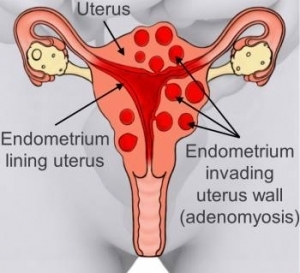What is adenomyosis?
Adenomyosis is when cells like the lining on the inside of your uterus are also in the muscle wall of your uterus. Studies suggest that about one in five women have this condition.
The below picture shows a uterus affected by adenomyosis.

Women with adenomyosis often have endometriosis too, but the conditions are different. With endometriosis, the cells are found on other parts of your body such as your fallopian tubes, ovaries or tissue lining your pelvis.
Adenomyosis only occurs in women who have periods, particularly women aged 30 to 50.
Adenomyosis and periods
With adenomyosis, the cells in the muscle wall behave the same way as cells lining the uterus. When you have your period, the cells in the muscle wall also bleed. But because they are trapped in the muscle layer, they form little pockets of blood in the muscle wall.
Symptoms
About two-thirds of women with adenomyosis experience:
- painful periods
- heavy periods
- iron deficiency (anaemia) due to heavy periods, which can make you feel tired or dizzy
- painful sex (dyspareunia)
- persistent pelvic pain.
Causes
We don’t know the exact cause of adenomyosis, but it may be associated with:
- uterine surgery
- cells occurring in the muscle wall of the uterus before birth
- inflammation of the uterine lining after having a baby, causing cells to pass into the weakened muscle layer.
Diagnosis
Your doctor will ask questions about your symptoms and may ask to do a vaginal examination. If you have adenomyosis, your uterus might feel tender or enlarged.
Adenomyosis can be hard to diagnose because there are no agreed tests to confirm the condition.
Your doctor might refer you to a gynaecologist. Depending on your situation, they may do a transvaginal ultrasound (an ultrasound probe is gently placed into your vagina).
You may also need an MRI scan to exclude other conditions, such as fibroids, and confirm the diagnosis.
Adenomyosis cannot be diagnosed from blood tests or tissue samples (biopsies). Diagnosis is often only confirmed with pathology tests after the uterus has been removed (hysterectomy).
Fertility and pregnancy
Adenomyosis can cause fertility problems because the condition makes it hard for an embryo to implant into the uterine lining.
There may also be pregnancy complications, and anaemia from heavy bleeding.
Treatment and management
Treatment will depend on your symptoms, your stage of life and whether you plan to have children.
Hormonal treatments
Research shows the Mirena® IUD has the best outcomes for managing symptoms of adenomyosis. The combined oral contraceptive pill may reduce bleeding and pain, but research suggests it is not as effective as the Mirena® IUD. You can stop either treatment if you are planning a pregnancy.
Surgery
If you are not planning any future pregnancies, you can have an operation to remove the uterus lining (endometrial ablation) to reduce heavy bleeding.
If your symptoms stop you from doing normal activities – and you don’t want to have a child or more children – you can have an operation to remove your uterus (hysterectomy).
Radiological treatment
Uterine artery embolisation is a nonsurgical procedure that blocks blood supply to part of the uterus. This procedure reduces pain and bleeding. But it is not recommended if you are planning a future pregnancy.
Talk to your doctor or specialist about the benefits and risks of each option before you decide.
When to see your doctor
Talk to your doctor if your symptoms (physical and emotional) stop you from doing things you normally do.
For more information, resources and references, visit the Jean Hailes ovaries and uterus web page.
© 2026 Jean Hailes Foundation. All rights reserved. This publication may not be reproduced in whole or in part by any means without written permission of the copyright owner. Contact: licensing@jeanhailes.org.au
